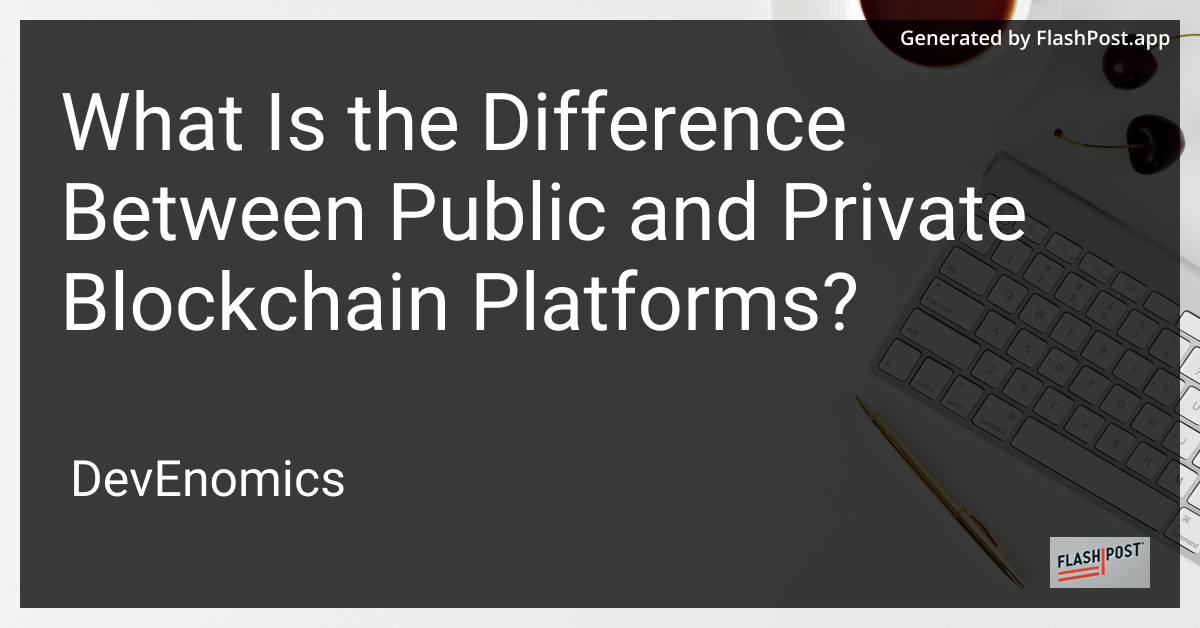

What Is the Difference Between Public and Private Blockchain Platforms?
title: The Difference Between Public and Private Blockchain Platforms description: Discover the key differences between public and private blockchain platforms and understand their distinct features, benefits, and use cases. keywords: blockchain, public blockchain, private blockchain, blockchain platforms, cryptocurrency, blockchain technology
In the rapidly evolving world of blockchain technology, understanding the differences between public and private blockchain platforms is crucial for leveraging their unique capabilities. Whether you’re a business leader, developer, or blockchain enthusiast, gaining clarity on these differences can guide your strategic decisions and deployments.
What is a Blockchain Platform?
A blockchain platform facilitates the use of blockchain technology to develop applications and services. Known for decentralization, transparency, and security, blockchain platforms store data across numerous devices, leveraging cryptographic techniques to secure information.
Public Blockchain Platforms
Public blockchains are open networks where anyone can join and participate. They are decentralized and do not require permission from any central authority. This inclusivity extends to participation in the validation process for transactions.
- Decentralization: The network is maintained by multiple nodes (computers), ensuring no single point of control.
- Transparency: Transactions are transparent and visible to everyone on the network.
- Security: Robust consensus algorithms like Proof of Work (PoW) or Proof of Stake (PoS) secure the network.
Use Cases:
- Cryptocurrencies: Public blockchains power cryptocurrencies like Bitcoin and Ethereum, enabling peer-to-peer digital currency exchanges.
- Decentralized Applications (dApps): Platforms for developing open-source applications where no single entity has control.
Private Blockchain Platforms
In contrast, private blockchains are restricted networks requiring permission to join. They are typically used in enterprise environments where privacy and efficiency are prioritized.
- Control: Access is controlled, and only selected participants can view or add to the blockchain.
- Performance: Generally offers faster transaction speeds due to the smaller number of nodes compared to public blockchains.
- Privacy: Offers higher levels of privacy, suitable for organizations with sensitive data.
Use Cases:
- Enterprise Solutions: Used for supply chain management, internal audits, and secure, private transactions within a corporation.
- Consortium Blockchains: A type of private blockchain where multiple organizations share administration.
Key Differences
- Access: Public blockchains are open to anyone; private blockchains require permissions.
- Control: Public blockchains operate under decentralized control; private blockchains are centralized within a governing organization.
- Consensus Mechanisms: Public blockchains use decentralized algorithms, while private blockchains may use more streamlined consensus methods to boost efficiency.
In conclusion, selecting between public and private blockchain platforms depends on specific needs and objectives. Public blockchains are ideal for applications needing transparency and decentralization, like cryptocurrencies. In contrast, private blockchains cater to use cases demanding confidentiality and speed, such as enterprise solutions.
To delve deeper into the functionalities of blockchain, explore blockchain trading platforms or grab some top blockchain book offers. As we move towards the future, understanding how blockchain impacts fintech in 2025 and beyond is critical for innovating the financial landscape.
